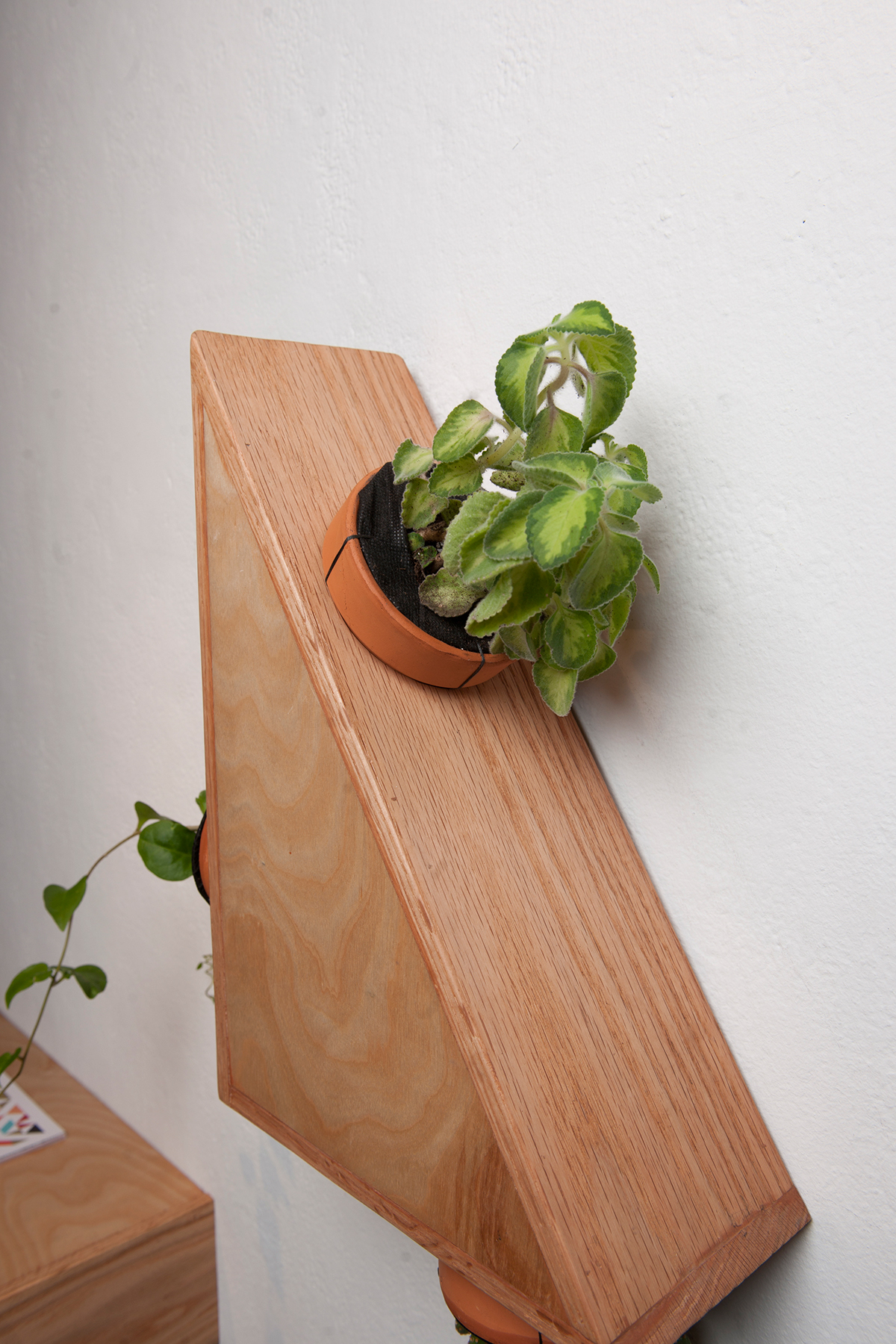
The Indoor Plant Module brings plants indoors with a form designed for functionality in both public and private spaces. The module embodies a simple form and features a plant/air friendly wood finish with consideration for indoor air quality, aesthetic appeal, ability to adapt to unique interior spatial limitations, and user interaction.
The hand–crafted right triangular forms are a vehicle for the plants which raise indoor air and aesthetic qualities. The dynamic form is inspired by the spatial limitations of the contemporary urban dweller and realized through the deconstruction of the rectangle.
As the modern world continues to increase in pace, The Indoor Plant Module is a way to slow down and enjoy natural beauty in your interior spaces.














PROCESS
Early in the process of this project I realized that deconstruction was going to provide me with the answer to my question of what form the Indoor Plant Module should take.
After much time researching existing indoor plant integration objects and noticing that the majority of them were a variation of the rectangle (and if not a rectangle then a shape that often seemed contrived), I came to a realization that I did not want the Indoor Plant Module to be the same rectangle or just some random shape resulting from lack of visual investigation.
After much time researching existing indoor plant integration objects and noticing that the majority of them were a variation of the rectangle (and if not a rectangle then a shape that often seemed contrived), I came to a realization that I did not want the Indoor Plant Module to be the same rectangle or just some random shape resulting from lack of visual investigation.
I started finding the first inkling of the Indoor Plant Module during this exercise; I cut up roughly forty of the same dimension rectangle and then proceeded to see how many ways I could dissect that rectangle (not all of the original deconstructions are shown here; ask if you want to see them all!)




After this process, I took my favorite cuts into Adobe Illustrator (I changed the random rectangle to a DIN rectangle for the sake of the syntactical relationship it shares with the human body) and then further extrapolated the possibilities of the juxtapositions of the cuts.
This is the point where I saw that the Indoor Plant Module was not just one form but a set of two separate forms resulting from the deconstruction of the DIN rectangle. This gives the user ultimate control of the module within their unique space.
This is the point where I saw that the Indoor Plant Module was not just one form but a set of two separate forms resulting from the deconstruction of the DIN rectangle. This gives the user ultimate control of the module within their unique space.


Having decided on the shape of the module, the exact size specifications needed to be set in order to start constructing the module in the wood shop. Here is the drawing that I used as reference during my time in the wood shop:

original sketch for the system which holds the soil in pots (even when upside down).

The Indoor Plant Module draws ideological inspiration from architect Frank Lloyd Wright, Arts and Crafts architect Charles Voysey and Arts and Crafts textile designer/artist and writer William Morris.
These designers advanced modern design in both the form and content of their architecture and design. The underlying ideology that unifies these artists is a common interest in man's relationship with nature and how that relationship can either be advanced or not in the design of the objects we surround ourselves with.
They all carried a traditional craftsmanship type approach and used simple form as a vehicle for a spiritual vision of a world where man and nature integrate seamlessly and design objects would be fused with fine art ideals. They spent their careers working towards making that vision a reality, with their works being a physical existence of their ideals. The Arts and Crafts movement influenced Art Nouvou and The Bauhaus movement
These designers advanced modern design in both the form and content of their architecture and design. The underlying ideology that unifies these artists is a common interest in man's relationship with nature and how that relationship can either be advanced or not in the design of the objects we surround ourselves with.
They all carried a traditional craftsmanship type approach and used simple form as a vehicle for a spiritual vision of a world where man and nature integrate seamlessly and design objects would be fused with fine art ideals. They spent their careers working towards making that vision a reality, with their works being a physical existence of their ideals. The Arts and Crafts movement influenced Art Nouvou and The Bauhaus movement
in terms of the melding of aesthetic and functional ideals and reacted against mass industrial design production and nationalism.
After coming to terms with the historical context of my product concept, I chose the typeface and brand colors which would best embody the ideology of the Indoor Plant Module:
Primary Typeface - Gill Sans Regular

Secondary Typeface - Gill Sans Light

Secondary Typeface - Gill Sans Bold Condensed

Brand Colors



